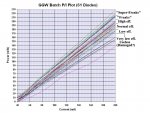Just curious, Igor, how will you decide who gets the "better" diodes ???
I mean the ones with: Higher wavelengths / higher efficiency..
You know what? You left the GB, you have no right to ask that question! :tsk:
Nah, just kidding, i knew it would come up sooner or later... I was thinking about it from the start.
It's very simple... I keep the best ones, and give the rest to others? :evil:
Ok, seriously now... I noticed one interesting thing about GGW diodes, which i already explained in FrancoRob's thread (about te 8x i made for him)...
The GGW diodes we got from reject sleds varied ALL OVER THE PLACE! Some were so weak they could not possibly work in a drive at all, one even had two kinks!
Their wavelengths were all over the place as well, and that's not all! There were different sled versions! And different sled versions contained different GGW diodes. Same diodes but different characteristics - consistent within that sled version!
- v3 for example were ALL without exception SUPER FREAKS, with high wavelength on top!
- v1 were almost as good as v3.
- v2 were all over the place - anything from horribly bad to exceptionally good, like v3's.
But whenever i get a diode from a DRIVE instead of a reject sled, something interesting happens. The efficiency variations are small! Barelly worth mentioning sometimes! Wavelength variations are also small! They seem to stick to 405-408nm!
For diodes to work consistently in a drive, they have to be..... Consistent! If they are not, they get rejected, and sold to the Chinese, who then sell them to us...

But because of those abnormalities in GGW sleds, i now believe the GGW reject sleds were - or at least contained -
PROTOTYPING REJECTS!!
Especially since there were clearly different sled versions, and weird diodes in them! Some of them VERY WEIRD!!!
I don't know for sure yet, but i don't expect 8x's (from Drives!) to vary a lot by wavelength (OR efficiency)! They have to slightly, it doesn't work any other way physically, but i wonder if it'll even be noticable (wavelength i mean, efficiency will be slightly noticable)?
So basically we will end up with a group of PIV plots with diodes maintained at constant temperature during plotting, to guarantee reliable results.
We will cut the two lowest plots off the chart, and sacrifice them to the Lazor Gawds...
The rest of them will ALL be good diodes! In fact, even the two "bad" ones will be GOOD DIODES!
So far, everyone who bought a drive got a good diode and was able to make a high power laser out of it!
Some had to set the current a little higher, others a little lower, but everyone was able to make a 400mW+ laser, if they wanted to!
In this case, two weakest ones go away, so the rest will be slightly better!
If i was asked to ultimatelly set them all to the same power, there might be a few mA more on one, less on the other, but that's it...
Other than that, i don't expect anything bizzare to happen...
If however anything bizzare does happen, we will have to come up with a plan... We'll figure it out once we get there!
 EDIT:
EDIT: A more simple answer to your question as to WHO gets the better diodes is:
-
Everyone! The weakest two get sacrificed for scientific purposes, so EVERYONE get's better diodes... :yh:
Imagine that this was a regular "GB" without any sacrifices to the Lazor Gawdz! Then someone would also have to get the weakest two diodes! Now they won't!
It's gonna be easier to disseminate the better diodes than to decide WHO gets the worst ones!
But as i explained above about drives, it is my belief, that EVERY DIODE that comes from a drive MUST be a good one, the efficiency differences present are compensated for by more or less current in the drive itself, and all drives can burn at the same speed in the end!
I don't expect to find severelly BAD diodes in drives! This is a completelly different world from reject-sleds!
EDIT2: Imagine red laser diodes, open cans more specifically... They too vary in efficiency (and wavelength)... But because they are more powerful diodes as well as more advanced, they are more consistent than their lower power versions.. The variations are present, but SMALL, very small!
The same thing is happening here now with BluRays. The higher the power of a diode we get, the more consistent they are!
And 8x's are already putting out WAY more power than open cans, which is funny seeing how they are rated for less!
* :thinking:
* And this is preciselly WHY i wanted to do this experiment!




